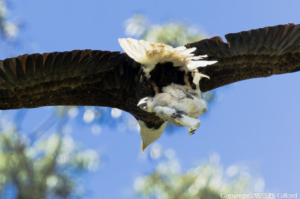When the LA Times was looking to do a story about the perils of wind energy for birds, including condors near the Tehachapi Mountains, they traveled north to visit Doug Bell and Joe DiDonato, two long-time East Bay biologists who have spent decades studying raptor fatalities at the wind turbines at Altamont Pass. Last week, I got to head out into the field to see how this work is done.
As we drove east toward Livermore, DiDonato laid out the big picture. “Alameda County has the highest density of nesting golden eagles anywhere in the world,” he explained, “which is surprising for being in the Bay Area.”
But the center of that eagle density is not the urban wilds of Oakland, but rather the open grasslands in the eastern part of the county. Those open spaces around Altamont Pass are rife with ground squirrels, prime eagle prey, but they are also dotted with windmills–which you might call prime eagle predators.
Bell is the Wildlife Program Manager for the East Bay Regional Park District, and DiDonato, who also served with the park district for almost 20 years, is now an independent biologist and wildlife photographer.
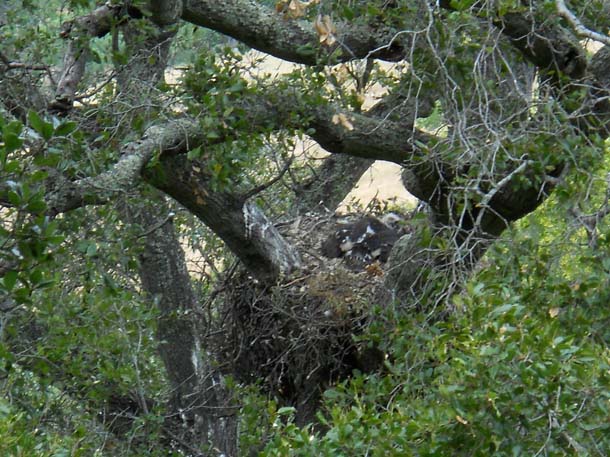
- This eaglet, about six or seven weeks old, is in a nest in the crook of an oak tree, seen here from the steep slope that rises above the tree. Photo by Isaura Linares.
The two scientists are working on a study that aims to determine how those wind turbines are affecting golden eagles because an alarming percentage of the population has been killed due to the proximity of turbines to the eagles’ nesting area.
As we drove along La Costa Creek, through San Francisco Water Department property, the first thing I noticed was that the rolling hills were studded with grazing cattle. DiDonato took the opportunity to explain how their grazing related to the birds we were about to see: cows eat long grass, which helps native plants sprout and sustain ground squirrels that feed birds of prey.
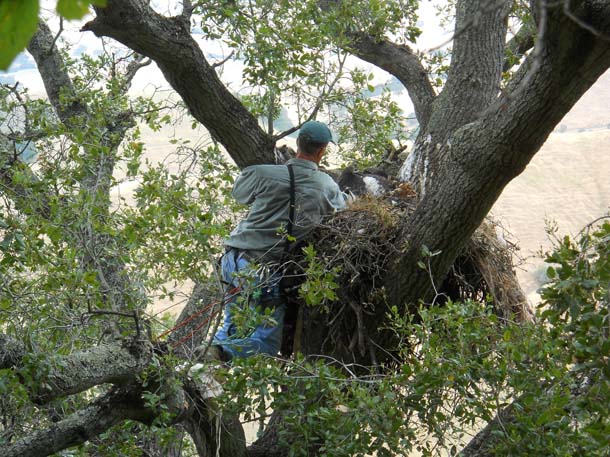
- Using a rope and harness he retrieved from the truck, Doug Bell climbed the tree, and carefully took the eaglet by the legs, put it in a cloth bag, and lowered the bird to the ground using a rope. Photo by Isaura Linares.
When we arrived at the site I realized we were not going to hike a clearly marked trail, as I had thought. We were going to scale the nearly vertical side of a giant mountain. For Bell and DiDonato, this was all in a light day’s work, but I am certainly not used to heading off-trail straight up a mountainside through thickets of poison oak. Especially for novice hikers, bushwhacking with biologists is a sobering experience.
And Bell and Didonato were not sure if we were going to be lucky enough to find the nest in the mountain’s woodland area, so they left much of their gear behind, opting for a backpack and a single machete.
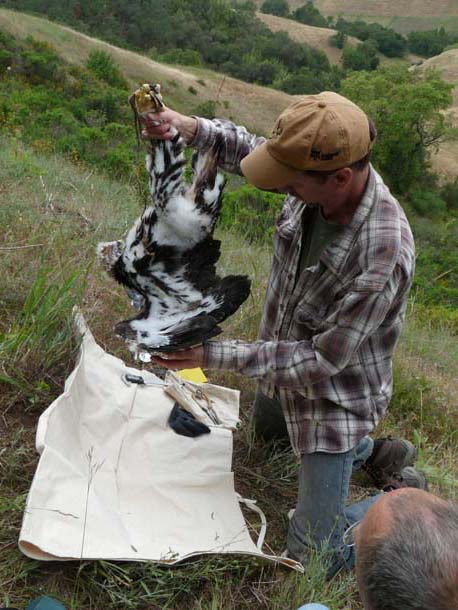
- DiDonato examines the eaglet after it has been lowered to the ground and removed from a cloth bag. Photo by Isaura Linares.
Just like that, without any further hesitation, off we went into the grasslands. I spent most of the hike trying to gain the mental (and physical) strength needed to keep up. DiDonato even offered a sturdy fallen branch for me to use as a hiking stick, which I happily accepted. They were more than patient with me; cracking jokes with one another (sometimes even at my expense) for the entire duration of the hike, which helped calm my nerves as I was convinced that every step I took was going to be my last.
We were there to look for nests; nests that we hoped would be full of eaglets. For the next couple of weeks, DiDonato and Bell will be looking for young eagles to fit with uniquely numbered bands.
If these eaglets are later found, dead or alive, the data collected using the bands could help demonstrate the fatal impacts on the local raptor population. Later this summer, Bell and DiDonato will shift their focus from banding juvenile golden eagles to trapping adult eagles and outfitting them with satellite tracking devices.
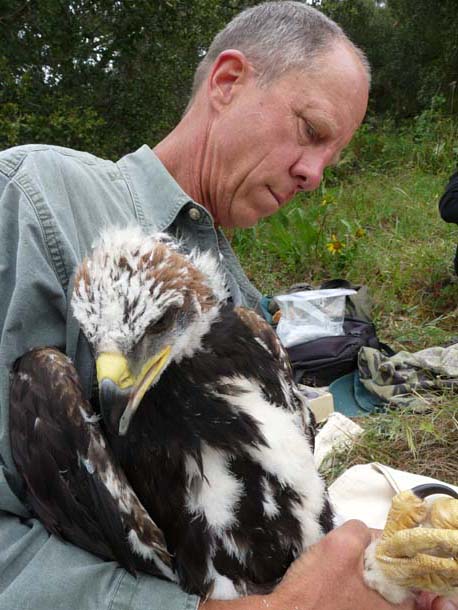
- Biologist Doug Bell finishes the examination of a juvenile eagle. Data from this work could help in efforts to reduce raptor fatalities at wind farms in the Altamont Pass. Photo by Joseph E. DiDonato, Wildlife Photography and Consulting.
As we hiked, Bell decided to venture off on his own, deep into the woodland area in search of the nest, while DiDonato and I enjoyed some temporary sanctuary in an area less densely populated by poison oak. With his binoculars DiDonato scanned the landscape for the nest while we listened for Bell’s call. After about 10 minutes of tense quiet, we heard his voice in the distance.
He’d found a nest in a tree that was easy enough to get to so long as you overlooked its position: projecting from one of the steepest sides of the mud-covered mountain. When we arrived, the eaglet was resting obliviously, with its back turned toward us. While the size and scale of the nest was impressive, these were obviously cramped quarters for the growing eaglet, which stood at a good 18 inches tall.
After a quick trip back to the car for his gear, Bell slipped into a harness and was ready to climb the tree and capture the eaglet in a special cloth bag. As the eaglet became increasingly aware of Bell’s presence in the tree, I worried it would attempt to escape. Ever the expert, Bell calmly approached the nest, took a few minutes to strategize, and quickly went to work. He reached in for the bird’s ankles and held on tight. The eaglet was startled and began to spread its wings. After a few failed attempts, Bell managed to turn the eaglet on its back and tuck it safely inside the bag. Bell fashioned a pulley out of rope and lowered the eaglet down to DiDonato, who measured and banded the bird.
With the measurements taken from its beak, talons, and wings, DiDonato and Bell were able to determine the eaglet was female and about six or seven weeks old. Bell also took a blood sample to send to a federal laboratory in Alaska, where it will become part of a larger study examining the overall evolution of birds in Western United States. After recording and banding the eaglet, Bell and DiDonato safely returned her to her nest.
For Bell and DiDonato, this was all in a day’s work. But, for me, finding myself so close to an eaglet turned out to be a life-changing experience–made all the more so by seeing DiDonato and Bell tromp fearlessly through poison oak and up steep, muddy slopes to climb a tree and then so delicately handle the baby eagle with care and respect.
Like DiDonato told me before the hike, it was a rare opportunity that not a lot of people get the chance to experience.

.jpg)


